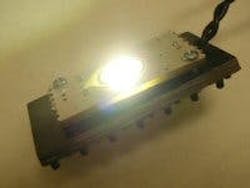TECH NOTES: ThermaLynk LED packaging technology from Lynk Labs moves goalposts for LED packaging and assembly
ThermaLynk offers an integrated thermal solution for LED packaging that was developed by Lynk Labs in collaboration with Cool Polymers Inc. of Warwick RI. Lynk Labs initially looked at how CoolPoly® thermal conductive material was being utilized as a replacement for metal core PCBs in LED assemblies. "We use several methods to form circuits on our polymer substrates, providing a moldable replacement for metal core PCBs,” says Gary Arnold of Cool Polymers.
Lynk Labs realized the CoolPoly® materials could offer significant advantages if taken down to the LED die level. The result is 2 new patented methods of packaging LEDs including LED packages made of thermal conductive plastics and what Lynk Labs refers to as "Chip On Luminaire" (COL™). In the COL concept, LED die are placed directly on a ThermaLynk luminaire molded into any form of end product such as an automotive tail light, traffic signal or backlight for displays.
The die is adhered to a substrate or heat sink slug that is then typically encapsulated in a plastic that is not thermally conductive. This essentially seals in the heat around the package, reducing thermal conduction paths to only the package bottom or lead frames. The lead frames are typically insert-molded into the plastics, and phosphors and/or a lens are applied.
Figure 3 illustrates the ThermaLynk technology advantage, which provides a way to integrate several of the LED package materials used today into a single, moldable structure. Crucially, this has heat transfer properties equal to aluminum, which is the lowest cost and most readily formable material presently used in LED module construction. ThermaLynk technology advantages can be leveraged into both high power and low power LED packages.
For high power packages mounted to ceramic or metal core PCB, it is necessary to add a finned aluminum heat sink and/or integrate the assembly into a finned luminaire. A typical LED package assembly today may look something like the one shown in Figure 5.
ThermaLynk technology enables aesthetic heat sinking to be molded right into the package design thereby increasing the heat transfer surface area around the LED die where all the heat is produced. Compared to aluminum heat sinks, CoolPoly materials can be 3D net shaped, and half the weight and cost to produce.
Since ThermaLynk technology reduces the number of manufacturing and assembly steps, as well as the number of different materials, it can enable an LED package assembly (such as the one shown in Figure 5), to be molded into a single-structure LED package looking something like the one shown in Figure 6. The entire area in blue can be molded into a single structure equal to aluminum, fins and all.
Thermal management of the LED package and luminaire is presently one of the fundamental challenges for LED research and product design development needed to realize the cost/performance advantages of LEDs in solid state lighting. Lynk believes the manufacturing and cost advantages ThermaLynk enables can be leveraged all the way up to the luminaire and to the end customer.
“This is where the real fundamental industry change occurs” says Stewart Hough, VP Business Development at Lynk Labs. “Today’s LED packaging process at the discrete device level comprises multiple steps and materials. ThermaLynk technology applied to Chip On Luminaire products reduces materials and process count to create a profound improvement in the cost structure needed to take LEDs to broad market applications and customer penetration.”
The company has already started developing samples of LED packages and Chip On Luminiare assemblies with potential licensing partners and is discussing several applications with OEMs including backlighting, traffic signal, and automotive lighting COL assemblies.
